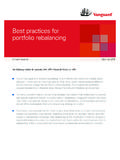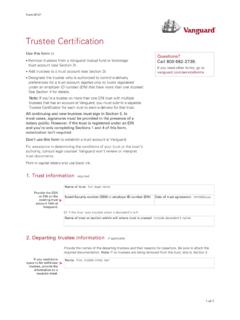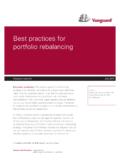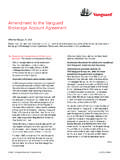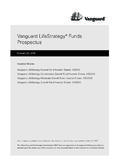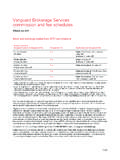Transcription of Global equities: Balancing home bias and diversification
1 Connect with vanguard > Equities not domiciled in the United States accounted for 51% of the Global equity market as of December 31, 2013,1 reflecting a significant opportunity for portfolio diversification . Despite the size of markets, mutual fund investors held, on average, only 27% of their total equity allocation in f u n d s a s o f y e a r - e n d 2 0 1 3 , a c c o r d i n g t o M o r n i n g s t a r. This paper concludes that although no one answer fits all investors, empirical and practical considerations suggest a reasonable starting allocation to stocks of 20%, with an upper limit based on Global market capitalization, subject to the investor s perspective on the short- and long-term research February 2014 Note: This paper is an update of a paper by the same author published in 2012 and titled Considerations for investing in Sources: Thomson Reuters Datastream and MSCI, as of December 31, equities: Balancing home bias and diversificationAuthorChristopher B.
2 Philips, CFA2 As of December 31, 2013, equities accounted for 49% of the Global equity market. equities, including those of developed countries such as Germany, Japan, and the United Kingdom, plus those of emerging countries such as Brazil, India, and China, accounted for the remaining 51%. As shown in Figure 1, the 2013 market capitalization was below the recent high of 55% of the Global equity market, reached in March 2003, but remained significantly above the all-time low of 29%, reached at the peak of the Japanese stock market run in the late 1980s. A portfolio investing solely within the stock market thus automatically excludes over one-half of the Global opportunity case for investing in stocksBeyond the opportunity to invest across a broader market, equities have diversified the returns of equities, on average, across time.
3 The rationale for diversification is clear stocks are exposed to economic and market forces, while stocks domiciled outside of the United States offer exposure to a wider array of economic and market forces. These differing economies and markets produce returns that can vary from those of stocks. Figure 2a, on page 4, shows that, all else being equal, a investor should realize a diversification benefit from investing globally because the equity markets of other developed economies are less-than-perfectly correlated with the equity market. At a high level, the benefit of Global diversification can be shown by comparing the volatility of a Global index with that of indexes focused on either the market or markets in isolation. In Figure 2b, on page 4, the benefit of diversification is clear: Although each individual country has experienced greater volatility than that of the United States, the broad MSCI World Index ex USA, which focuses on developed markets, has experienced volatility more similar to that of the United States.
4 And when taken one step further, the broadest Global index representing the combined MSCI USA Index, the developed markets index, and the MSCI Emerging Markets Index has realized the lowest average on risk: All investments are subject to risk, including possible loss of principal. diversification does not ensure a profit or protect against a loss in a declining market. Investments in securities issued by companies are subject to risks including country/regional risk and currency risk. These risks are especially high in emerging performance is not a guarantee of future results. The performance of an index is not an exact representation of any particular investment, as you cannot invest directly in an mix of Global equity market capitalizationNotes: market represented by MSCI USA Index; market represented by MSCI World Index ex USA from 1969 through 1987 and MSCI All Country World Index ex USA thereafter.
5 Data as of December 31, : Thomson Reuters Datastream and capitalization02040608010 0% market1969197319771981198519891993199720 01200520092013 Can multinational corporations provide enough exposure? One common question regarding exposure to stocks is whether enough coverage of foreign markets is embedded in the prices of multinational companies such as McDonald s, , or ExxonMobil. The thinking goes that because many large firms generate a significant portion of their revenue from foreign operations, the diversification benefits of Global investing are already reflected in the prices and performance of large firms. While this aspect of globalization cannot be ignored (and certainly can have an impact on investors portfolios), we believe it still makes sense for investors to hold investments, for several reasons.
6 First, simply focusing on companies means an investor has no stake in leading, Global companies that are domiciled in other countries such as Samsung, Toyota, or Nestl . Second, many firms seek to hedge away currency fluctuations of their foreign operations. Although this can help to smooth revenue streams, foreign exchange can be a diversifier for investors. Lastly, a portfolio made up solely of firms, which are more concentrated in biotechnology, computer equipment, information technology and IT services, and software, would be underweighted in old world industries such as electrical equipment, durable household goods, and automobiles. In other words, an portfolio would lose not just investment opportunities but also the diversification benefits of a portfolio that s more evenly distributed across Given Global exposure, how much?
7 The decision to invest globally is only the first step. The next step is to determine an appropriate allocation. The standard financial-theory approach, whether for allocating globally or within a specific country or market, is to invest proportionally according to market capitalization. This method assumes that markets are reasonably efficient and that stock prices reflect all the available information, investment positions, and expectations of the investing community. As shown in Figure 1, equities currently make up approximately 49% of the Global market. According to this theory, then, investors would currently have 51% of their equity portfolio in equities, and this weight would fluctuate with market performance. However, few investors follow this approach to the letter; instead, they more often choose a set allocation and then periodically rebalance to that level.
8 For many investors such an approach represents a reasonable trade-off between the opportunity for diversification and the realities of the Global equity markets. For example, despite increasing efficiencies, Global markets are not yet fully and seamlessly integrated. The fact remains that costs such as expense ratios, bid-ask spreads, frictional costs, and even market-impact costs continue to be higher for markets outside of the United States. In addition, local investors across the world (including in the United States) are influenced by embedded home biases, probably a result both of regulatory constraints, such as explicit limits on public pension funds allocations, and behavioral tendencies. For example, according to Philips, Kinniry, and Donaldson (2012), investors maintained an allocation to stocks that was approximately the market cap of Figure Correlations of returns in foreign equity markets with equity marketsCorrelations and volatility of equity returns of countries and regionsNotes: Country returns represented by MSCI country indexes; emerging markets represented by MSCI Emerging Markets Index; developed markets represented by MSCI World Index ex USA; Global market, including both developed and emerging markets, represented by MSCI All Country World Index.
9 Emerging market data begin in 1988; all data through December 31, : vanguard , Thomson Reuters Datastream, and MSCI. b. Volatility of returns for country and regional indexes Correlation marketsAverageHong KongUnited StatesAustraliaAustriaBelgiumCanadaDenma rkFranceItalyHong KongJapanNetherlandsNorwaySpainEmerging marketsDeveloped marketGermany010203040%Annualized standard stocks, while the next-closest investors in terms of bias to home market cap were those in the United Kingdom, who maintained a relative home bias of about the market cap of stocks. Whatever the underlying driver, the local home biases of investors in each country aggregate to form a Global market that is not fully representative of the theoretical free-floating investor experience, which would be the objective of a fully market-proportional portfolio. As a result, a case could be made for a dedicated allocation to stocks that differs from the Global market-weighted portfolio simply based on awareness of local and Global biases (whether justified or not).
10 Historical minimum-variance analysis When deviating from a market-proportional approach, a natural question is: What represents a reasonable allocation? One simple methodology is to conduct an analysis evaluating the diversification impact of various combinations of and stocks over time. Figure 3 shows the results of a minimum-variance analysis between stocks and stocks (and bonds) since 1970. We elected to focus on volatility under the assumption that over the long term, returns across developed countries should be more similar than different. The downward-curving lines indicate that adding stocks to a portfolio would have led to incrementally greater levels of diversification in the form of reduced portfolio volatility over the period studied. Figure annualized change in portfolio volatility when adding stocks to a portfolioAdding stocks has historically reduced the total volatility of a portfolioNotes: equities represented by MSCI USA Index; equities represented by MSCI World Index ex USA from 1970 through 1987 and MSCI All Country WorldIndex ex USA thereafter.
